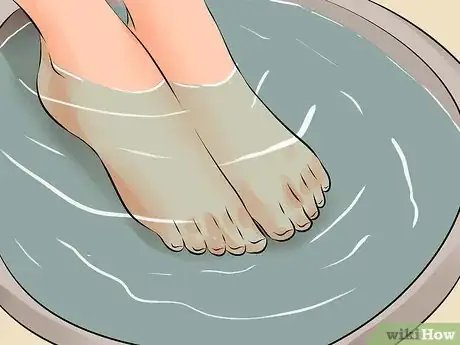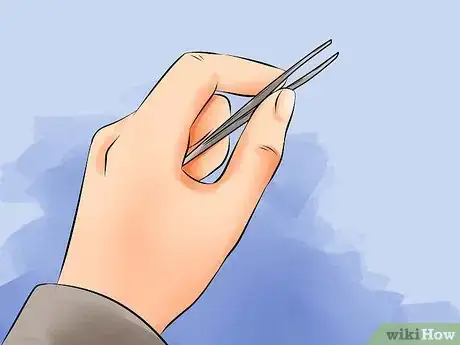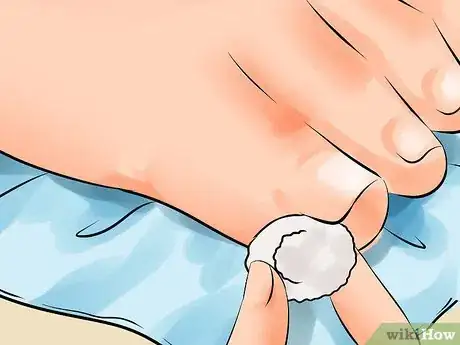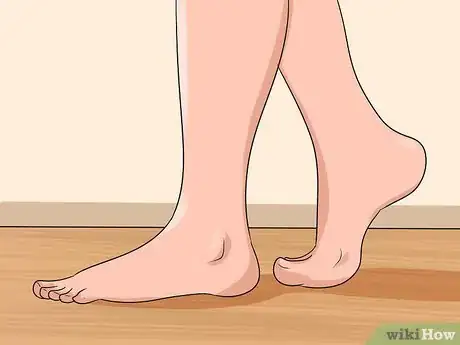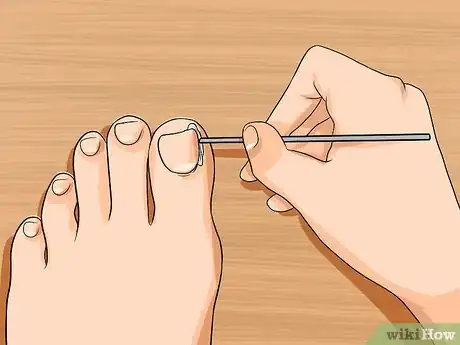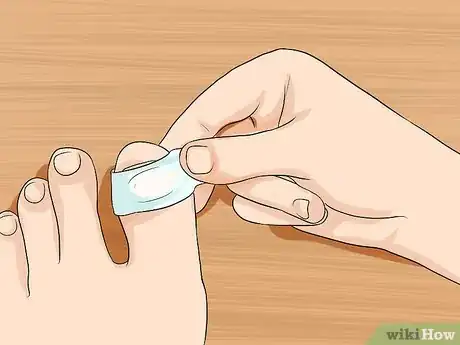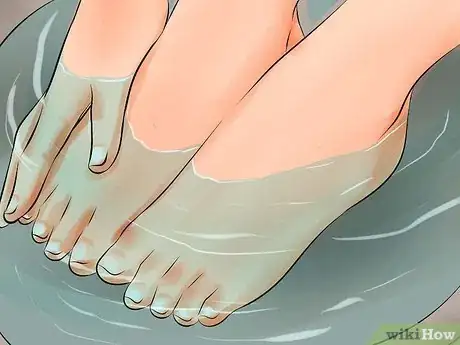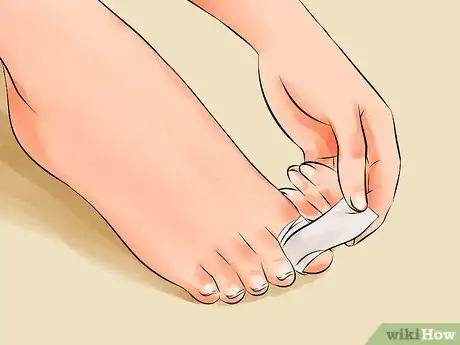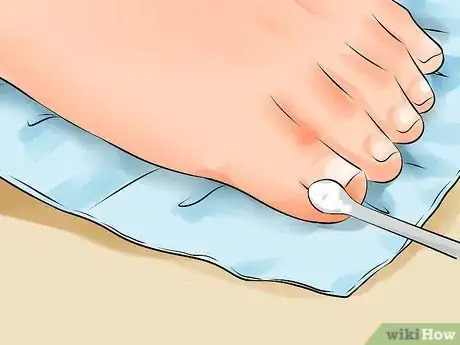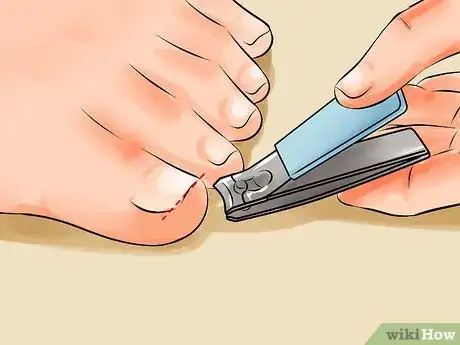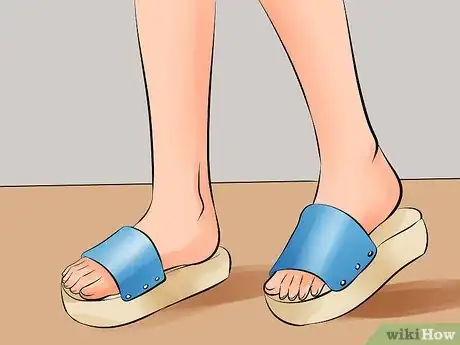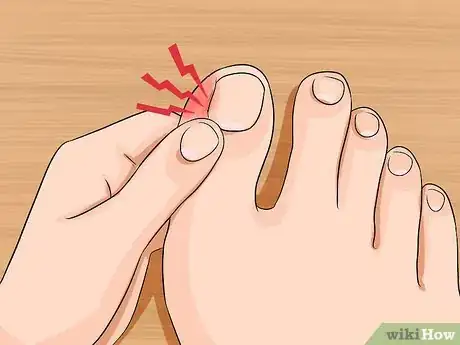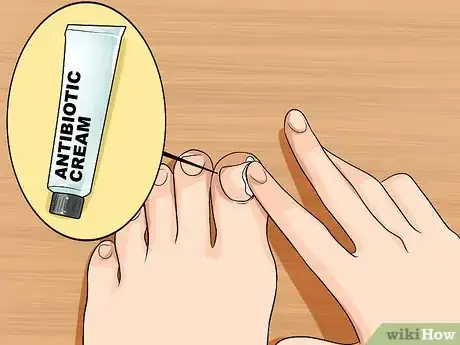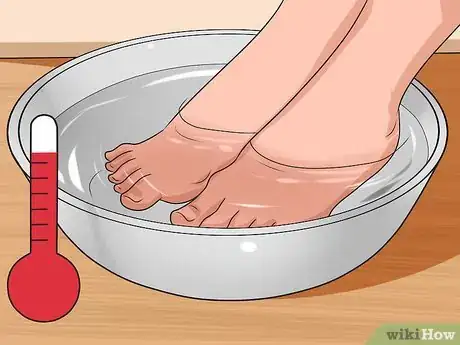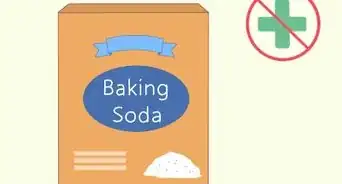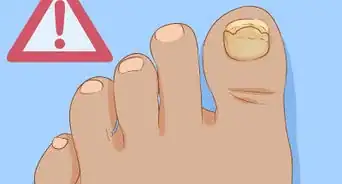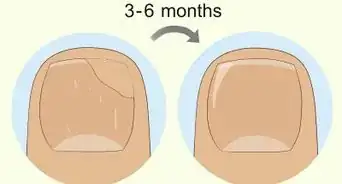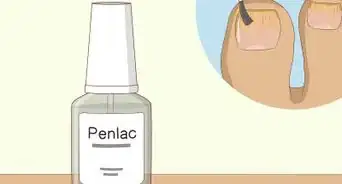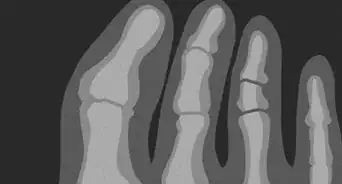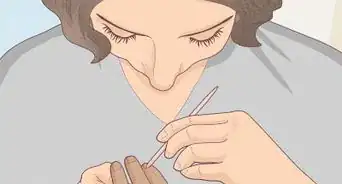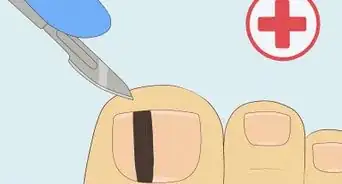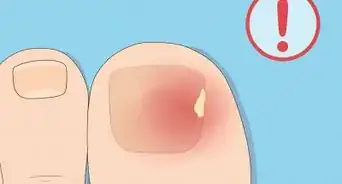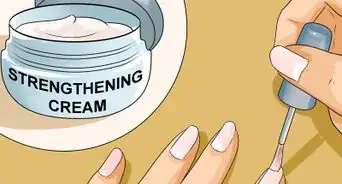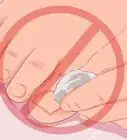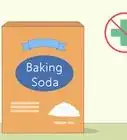This article was medically reviewed by Sarah Gehrke, RN, MS. Sarah Gehrke is a Registered Nurse and Licensed Massage Therapist in Texas. Sarah has over 10 years of experience teaching and practicing phlebotomy and intravenous (IV) therapy using physical, psychological, and emotional support. She received her Massage Therapist License from the Amarillo Massage Therapy Institute in 2008 and a M.S. in Nursing from the University of Phoenix in 2013.
There are 14 references cited in this article, which can be found at the bottom of the page.
wikiHow marks an article as reader-approved once it receives enough positive feedback. This article received 24 testimonials and 85% of readers who voted found it helpful, earning it our reader-approved status.
This article has been viewed 5,376,255 times.
An ingrown toenail can be painful and unpleasant. However, there are things you can do to stop your toenail from growing into your skin. Doing so may even prevent you from having to get surgery to remove the ingrown toenail! Just make sure that your ingrown toenail is not infected by checking for warmth, pus, redness, and swelling. If you notice any of these signs of infection, see a doctor.[1]
Steps
Packing an Ingrown Toenail
-
1Check with your doctor or podiatrist first if you are diabetic. It is important to keep your feet clean and to check for problems, such as ingrown toenails, if you are diabetic. However, your doctor may prefer that you do not try to treat an ingrown toenail yourself for safety reasons. Call your doctor and ask before you attempt any home treatments.[2]
-
2Soak your foot in a mixture of cool to warm water and Epsom salt. Hot water will cause the area around your ingrown toenail to swell, so don't use hot water.[3] Do this for 15-30 minutes at least twice daily. The goal here is twofold: to soften the toenail and prevent the ingrown nail from becoming infected.Advertisement
-
3Gather your tools and get ready. Get a cotton round, cotton ball, or any unflavored or unwaxed dental floss ready, a pair of disinfected tweezers, and a toenail lifter.
-
4Keep your toenail slightly raised. Using a disinfected tool to place a small piece of cotton or unflavored dental floss between your toenail and the skin should keep the ingrown toenail from coming back.[4]
- If you are using a cotton round or cotton ball, remove a small piece of cotton with the tweezers. If you are using unflavored dental floss, cut a 6 inches (15 cm) piece of dental floss.
- Lift the corner of the ingrown toenail with the disinfected tweezers and gently work the cotton or dental floss under the nail. If desired, you may apply an antiseptic ointment, such as Neosporin, to the cotton or floss before sliding it under the nail.
- Do not try to put the cotton or dental floss under the nail if the nail bed looks swollen or red.
- Remove the cotton or dental floss daily, cleanse the area, and replace with new cotton or dental floss to reduce the risk of infection.
-
5Give your toe some air! Don't wear socks or shoes when you're at home.
-
6Check back. If you keep the cotton or dental floss splint in place and treat your feet well, your ingrown toenail should grow back out within a few weeks.
- Replace the cotton every day to keep the toe from becoming infected. If the toenail is painful, replace the cotton every other day, checking daily for infection.
-
7Ask your healthcare provider about taping. If your nails are still cutting into the skin, then you may also consider trying taping. Taping is when you secure a band-aid to the bottom of your toe and pull the skin away from the location where the nail is cutting into the nailbed. The trick is to move the skin away from the offending nail with the help of a band-aid. This can decrease pressure in the area, and if done properly, promote drainage and drying. However, you may want to ask your healthcare provider to show you the proper way to do this because it can be difficult to master.[5]
Trying Unverified Home Remedies
-
1Soak your foot in cool water that's been treated with a povidone-iodine solution. Put one or two teaspoons of povidone-iodine into cool soaking water instead of Epsom salts. Povidone-iodine is an effective antiseptic.[6]
- Keep in mind that this will not treat an ingrown toenail, but it may help to prevent an infection.
-
2Apply lemon juice and honey and bandage the toe overnight. Apply some fresh lemon juice and honey or Manuka honey to the toe.[7] Then wrap the toe with gauze and leave the bandage on overnight. The lemon and honey may help to fight the infection overnight.
- Lemon has antimicrobial effects, but it will not get rid of an ingrown toenail.[8]
-
3Use oils to soften the skin around the toenail. Oils applied to the toenails can help moisturize and soften the skin, reducing the pressure put on the toenail when you have to wear shoes. Try the following oils for fast relief:
- Tea tree oil: this essential oil is both an antibacterial and an antifungal agent that smells great.[9]
- Baby oil: another great-smelling mineral oil, this doesn't have the antimicrobial properties of tea tree oil, but works great for softening the skin.
Preventing Ingrown Toenails
-
1Keep toenails at a moderate length and trim them straight across. Nails that are rounded have a higher chance of growing into the skin around the toes, creating problems.[10]
- Use toenail clippers or nail scissors to trim toenails. Ordinary nail clippers are small enough that they tend to leave sharp edges near the corner of the toenail.
- Optimally, try to cut your toenails once every 2-3 weeks. Unless your toenails grow extremely fast, cutting your toenails often won't give them a good chance to become ingrown.
-
2Avoid getting pedicures while your ingrown toenail is still bothering you. Pedicures can aggravate the skin underneath the nail; pedicure instruments can be less than sanitary, worsening or causing an infection.
-
3Make sure your shoes are the right size. Shoes that are too small and press on your toenails can easily cause them to become ingrown. Opt for roomier, bigger shoes instead of smaller, tighter ones.[11]
- Try to wear open-toed shoes to prevent pressure on your toe. Since your toe should also be covered, use bandages or wear socks with sandals. Although this is unfashionable, it is better than having to get surgery.
-
4Be on the lookout if you regularly get ingrown toenails. If you get an ingrown toenail and do not care for it properly, then you are likely to get it again. However, you can take steps to prevent that from happening.
-
5Apply antibiotic cream to your feet twice a day. After you get out of the shower in the morning, and once before going to bed, apply antibiotic cream to the ingrown toenail and surrounding area.[12] Antibiotic cream will help reduce the risk of infection, which can lead to complications and increased pain.[13]
-
6Soak your feet in cool to warm, soapy water for 15 to 30 minutes. After soaking your feet, rinse them well to get all the soap off. Then, dry them well with a clean towel. You may also apply some Neosporin and a bandaid to protect the ingrown toenail area.[14]
Warnings
- Your toenail is very susceptible to infection when it is ingrown, so do your best to keep it covered and clean to avoid serious consequences.⧼thumbs_response⧽
- If your ingrown toenail is really swollen or has pus around it, it is most likely infected. See your doctor for some antibiotics before you insert the cotton or dental floss. Be aware that antibiotics simply reduce the infection and don't get the nail to grow back out, so the cotton or dental floss can be applied along with the antibiotics if your doctor approves of this method.⧼thumbs_response⧽
- If the cotton method along with antibiotics does not work, see your doctor or podiatrist because you may need to have the nail surgically removed.[15]⧼thumbs_response⧽
Things You'll Need
- Cool or warm foot soak
- Epsom salt
- Povidone Iodine
- Cotton round or cotton ball
- Tweezers or toenail lifter
- Antibiotic ointment
- Bandages
References
- ↑ https://www.mayoclinic.org/diseases-conditions/ingrown-toenails/diagnosis-treatment/drc-20355908
- ↑ https://www.niddk.nih.gov/health-information/diabetes/overview/preventing-problems/foot-problems
- ↑ http://drnoahblum.com/pdf/ingrown-nail-instructions.pdf
- ↑ http://www.mayoclinic.com/health/ingrown-toenails/DS00111/DSECTION=treatments-and-drugs
- ↑ https://www.ncbi.nlm.nih.gov/pmc/articles/PMC3362847/
- ↑ https://www.sciencedirect.com/science/article/pii/S1743919117305368
- ↑ https://www.ncbi.nlm.nih.gov/pmc/articles/PMC3609166/
- ↑ https://www.ncbi.nlm.nih.gov/pmc/articles/PMC4708628/
- ↑ https://www.ncbi.nlm.nih.gov/pubmed/9055360
- ↑ https://medlineplus.gov/ency/article/001237.htm
- ↑ https://medlineplus.gov/ency/article/001237.htm
- ↑ https://www.ncbi.nlm.nih.gov/pmc/articles/PMC1472971/
- ↑ http://www.webmd.com/skin-problems-and-treatments/understanding-ingrown-nail-treatment
- ↑ http://drnoahblum.com/pdf/ingrown-nail-instructions.pdf
- ↑ https://medlineplus.gov/ency/article/001237.htm
About This Article
If you have an ingrown toenail, soak your foot in a mixture of cool to warm water and Epsom salt for 15-30 minutes twice a day. This will soften the toenail and help prevent the ingrown nail from becoming infected. Lift the corner of your toenail with a pair of disinfected tweezers and place a small amount of cotton beneath the nail to keep it from growing into your skin. Replace the cotton daily. However, if the nail bed is swollen or red, you should see your doctor in case of an infection. Keep reading for tips from our medical reviewer on natural remedies that may help, like using tea tree oil.

